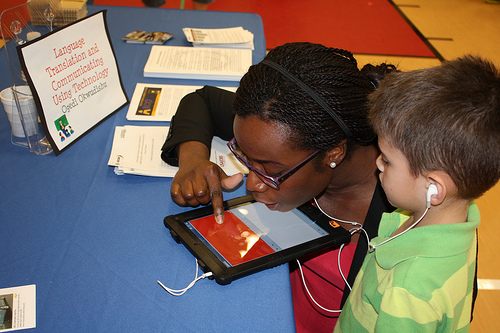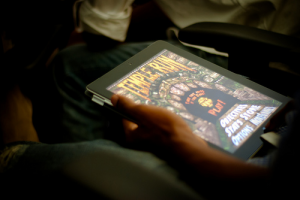Featured Image is sourced from Flickr.
As tablets become an increasingly ever-present part of our digital lives and touchscreen interfaces become second nature for children readily accustomed to playing games, watching videos and using applications on their parents’ tablets and smartphones, the idea of using tablets in an educational setting is becoming more attractive to a large number of teachers teaching a variety of age groups. Notably, the potential of tablet computers to enhance the learning of preschool and elementary schoolchildren is a particularly exciting prospect, and a significant amount of research has been devoted to the ways in which this can be achieved as well as the strategies that teachers must employ to ensure children remain engaged and that the use of tablets in an educational setting remains productive.
Of course, for many schools, the price of a tablet is crucial if it is to be used effectively, as funding continues to be cut and money for new initiatives becomes increasingly thin on the ground. Consequently, several manufacturers have introduced schemes offering high school or university students free access to devices and even training in app programming, like BlackBerry Academy or the Samsung Experience Academy. However, most of these schemes are aimed at older students rather than early childhood education. Unless donations can be secured, the affordability of different tablets will always be a key factor in decision making for educators; however, some tablets are relatively affordable. Reducing the outlay per tablet would allow a greater number of devices to be purchased, enabling greater class engagement.
A potent example of the learning potential of tablet devices is given in the article “Touch and Grow: Learning and Exploring Using Tablets” published in Young Children, the journal of the National Association for the Education of Young Children. This article discusses a teacher using a tablet to enhance children’s learning on sunflowers by providing a virtual tour of Vincent Van Gogh’s sunflower paintings and a Vincent Van Gogh electronic book. These electronic activities built on traditional physical learning such as examining sunflower seeds and reading informational texts. The article also details how the children, under instruction, could become accustomed to using the tablet themselves, using it to search the web for information about sunflowers and using a drawing app to draw pictures of sunflowers. Of these, the latter is particularly significant as, while a good deal of tablet use in the classroom entails using the intuitive nature of a touchscreen to fulfil browsing and video functions that were previously fulfilled by a laptop or desktop computer, drawing apps on tablets give something much closer to the actual physical reality of drawing for young children. These apps are vastly different from the experience of drawing with a mouse and cursor on a computer screen, and so are much more useful and fun. The on-screen keyboards on tablets can make it easy for children to search for information and create their own stories and texts in different apps; for example, The Verge’s BlackBerry PlayBook review notes that the on-screen keyboard is ‘really excellent’, which will benefit all tablet users but which will particularly be useful for those users with less dexterity or familiarity with tablets, such as small children.
This area of young children drawing on tablets is one that has attracted significant scholarly attention, with one of the most important studies being Leslie Couse and Dora Chen’s observation of the experiences of young children drawing on tablets as part of an early education class. Significantly, the authors found that, for many children, the experience was preferable to the experience of drawing with markers and pens, with key reasons for this being the fact that tablets negated the problem of ink or paint running out and simplified the complex process of mixing colours. The study also found that some children were able to produce work of a higher quality on tablet and that some who were resistant to drawing on paper were enthusiastic about drawing on a tablet, suggesting tablets may be helpful in catering to a wider range of learning styles and personalities.
While it is unlikely that criticism of children’s use of technology will ever completely disappear, most of this criticism is focused on how games and endless television watching might make children increasingly passive consumers, with the consequent lack of social interaction and physical activity being especially potent negative associations. However, the way tablets are employed in early childhood education differs significantly from commonplace uses of technology by children, as the tablets are not provided for games or to act as ‘electronic babysitters’, but rather to enhance interaction and communal learning. For example, drawing apps can actually aid in developing students’ fine motor skills, engaging children who would otherwise be resistant, and aiming to closely mimic the paper-based activity. Using the internet productively to find information is another crucial aspect of the use of tablets in the classroom, teaching children how to find reliable information online, and how to do this safely. In this regard, the choice of tablet is of particular importance, as it must be tailored to the classroom environment, rather than being the best platform for tablet gaming, for example. BlackBerry tablets may be a good option here, as they are especially well-suited for web browsing and video, with numerous BlackBerry PlayBook reviews having praised the tablet’s high resolution screen and high definition video capability. Both these features are likely to help keep young children engaged. A variety of drawing apps can also be used on the PlayBook, bolstering the tablet’s credentials as an educational tool. While the Apple and Android app stores offer a great variety of apps, the BlackBerry app store’s offerings are steadily increasing, making it a viable alternative for educators.
Overall, current research indicates that tablets can be a valuable addition to classroom learning, helping to enhance physical learning processes by providing teachers with new ways in which to engage their classes. This is particularly important for young children, whose shorter attention spans often limit their engagement with traditional texts or visual materials. Finally, establishing competency on touchscreens as early as possible is becoming increasingly important as these devices become an established part of our digital world, a process in which tablet classroom learning can play a vital role.







